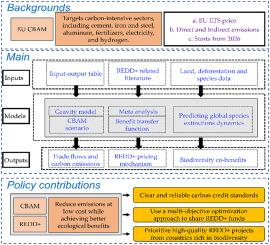通过对REDD+资金的多目标优化,将自愿碳抵消纳入碳边界调节机制
IF 8.4
2区 环境科学与生态学
Q1 ENVIRONMENTAL SCIENCES
引用次数: 0
摘要
将自愿碳市场(VCM)中的REDD+项目纳入碳边界调整机制(CBAM),可以增强其减排灵活性,并带来更大的生态效益。本研究采用多目标优化框架将CBAM收入分配给62个REDD+国家。研究发现:(1)CBAM可通过碳成本为欧盟带来261亿美元的年度收入,其中中国、美国、英国、土耳其和俄罗斯贡献最大。(2) 62个REDD+国家的森林保护机会成本差异很大,但仍低于发达国家的平均碳价格。(3)通过多目标优化框架配置REDD+资金,可获得显著的固碳效益和生态效益。本研究建议在VCM和CBAM之间建立一致的碳信用标准。多目标优化框架可以增强REDD+的资金配置。高质量的REDD+项目应该获得更多的优先权。这些项目带来了多种协同效益,包括生物多样性保护。本文章由计算机程序翻译,如有差异,请以英文原文为准。

Integrating voluntary carbon offsets into the carbon border adjustment mechanism through multi-objective optimization of REDD+ funds
Integrating REDD+ projects from the Voluntary Carbon Market (VCM) into the Carbon Border Adjustment Mechanism (CBAM) can enhance its emissions reduction flexibility and deliver greater ecological benefits. This study employs a multi-objective optimization framework to allocate CBAM revenues to 62 REDD+ countries. The study finds that: (1) CBAM could generate 26.1 billion USD annual revenue for the EU through carbon costs, with China, the United States, the United Kingdom, Turkey, and Russia contributing the most. (2) The opportunity costs for forest protection in 62 REDD+ countries vary widely but remain below the average carbon price in developed countries. (3) Allocating REDD+ funds through a multi-objective optimization framework can deliver significant carbon sequestration benefits and ecological gains. This study recommends establishing consistent carbon credit standards between the VCM and CBAM. A multi-objective optimization framework can enhance REDD+ fund allocation. High-quality REDD+ projects should gain more priority. These projects deliver multiple co-benefits, including biodiversity conservation.
求助全文
通过发布文献求助,成功后即可免费获取论文全文。
去求助
来源期刊

Journal of Environmental Management
环境科学-环境科学
CiteScore
13.70
自引率
5.70%
发文量
2477
审稿时长
84 days
期刊介绍:
The Journal of Environmental Management is a journal for the publication of peer reviewed, original research for all aspects of management and the managed use of the environment, both natural and man-made.Critical review articles are also welcome; submission of these is strongly encouraged.
 求助内容:
求助内容: 应助结果提醒方式:
应助结果提醒方式:


